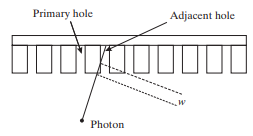An Anger camera collimator has the following dimensions: septal thickness h = 6 mm, septal height l = 10 cm, and hole diameter d = 3 mm. The detector thickness is b = 2.5 cm, and the range of the object z = 0.5 m
(a) Find the collimator resolution at the given range.
(b) Suppose the intrinsic resolution of the Anger camera is 0.2 mm. Write an expression for the overall PSF of the Anger camera at the given range, assuming both hC and hI are Gaussian.
Photons sometimes penetrate the collimator’s septa, which means that a photon entering one collimator hole can sometimes be detected under another hole, as shown in Figure P8.6.

Figure P8.6 Septal penetration by a photon. See Problem 8.16
In parts (c), (d), and (e), we consider the effect of septal penetration on collimator design and collimator resolution. Assume the linear attenuation coefficient for lead is μ.
(c) Assume a photon enters one hole, penetrates an adjacent septum and is detected in the adjacent hole. What is the minimum length w of the path through the septum as shown in the figure? (The result should be in units of mm.)
(d) Suppose we desire septal thickness to be large enough to stop 95% of the photons that pass through the minimum distance w. For fixed l and d, what inequality should h satisfy?
(e) How does septal penetration influence collimator resolution?
(f) Can we use the acceptance window to reject photons that penetrate septa and are detected in adjacent holes? Explain.
(g) A photon can be rejected if its Z-pulse is too small. What physical event(s) could cause this low Z-pulse?

